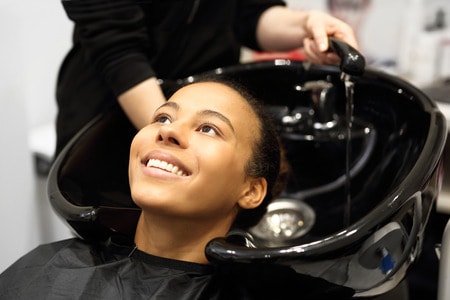Although many people describe hair as dead, this couldn’t be further from the truth. While hair is not alive in the most commonly understood sense, it is still something you can keep healthy, shiny, and bouncy. Nowadays, individuals often invest in specialized treatments to promote health and also give hair a fighting chance against the hazards of stripping, bleaching, dying, straightening, curling, blow drying, and other damaging treatments people use to give their hair their desired appearance.
If you want to keep your hair as healthy as possible, you need to know how porous it is.
Table of Contents
What Is Porosity?
You might be familiar with the word “porous,” which refers to whether or not an object is capable of absorbing water, usually through small holes in the structure. A sponge, for example, is porous. This principle applies to hair as well, though many people don’t realize it. Not all hair is made the same, and some individuals have hair which is extremely porous, meaning it absorbs products and water easily. This is known as high porosity.
If you have medium or standard porosity, your hair absorbs water and products at an average or regular rate. This does not mean that medium porosity implies the hair is “normal,” but rather it just happens to fall in the middle of the scale. If you have high or low porosity, you are still normal.
Hair with low porosity does not absorb liquids well. This means you tend to have a hard time getting your hair wet or moisturized, and it will not absorb product well. This can be a problem for people who frequently suffer from breakages and dry hair and scalp in general.
What Controls Porosity?![woman for hair treatment]()

Porosity is controlled by the cuticles in strands of hair. The cuticles are dead skin cells that form the outside of a strand of hair. Because they overlap, they form a layer of protection. When exposed to liquids, they can lift a little, allowing moisture to seep inside. Some people are naturally prone to high or low porosity by their genetics, but it’s still possible to make a few changes in the standard hair care routine to change this fact.
How to Test Hair Porosity
There is a simple way you can test hair porosity at home. All you need is a strand of your hair – preferably freshly plucked from your head – and a glass of water. Once you have these objects, drop the strand into the water and observe where it falls in the glass.
If your hair has high porosity, it will sink to the bottom of the glass because it’s absorbing the liquid around it. Strand only sinks to the middle of the glass? The hair has medium porosity and some fluid resistance. If your strand sits on top of the water or only sinks a tiny bit, it has low porosity and is struggling to lift its cuticles and allow the liquid inside.
Still Unsure?
If you’re still unsure about the results, most salons and hairdressers will be able to tell you your porosity after examining your hair. The porosity often affects how oily the hair gets and also how well highlights and dyes stick to the strands, so it’s important to figure out what type it is if you want to make a change to your standard look.
Another method is to just feel a single strand from its tip up to the root. Just run your fingers along it with a little pressure, but not too much. If you feel bumps along the way, you have high porosity. Those bumps are the cuticles spread. If you have low porosity, the entire strand will feel smooth and tight because the cuticles are sealed.
Finally, you can always spray a section with a misting bottle and see how it reacts. If the hair immediately absorbs the water, it’s highly porous. If beads of water sit for a few minutes and then get absorbed, it’s medium. Finally, if the beads of water just sit there for a long time, the hair has low porosity.
What You Can Do About It
Hair porosity is not static and it’s possible to perform treatments to help your strands either better absorb moisture or lock it in. People with high porosity typically have the most damaged hair because the cuticles are unable to form a shield. This means fluid enters, but then rapidly leaves as well. Sealing in moisture can be a major problem. If you want to give your hair a fighting chance, consider treating it with oils for moisture that help create a barrier that the liquids can’t escape through.
People with low porosity, meanwhile, need to try to ease the guard of the cuticles. What you should do is use products with alkaline ingredients. These ingredients lift the cuticles because of their high pH. Be wary of products with a low pH though, as though acids will close off the cuticles even more.
Finally, if you have medium porosity, you want to protect those cuticles and keep your hair healthy. The recommended course of action is to do regular deep conditioning treatments with nutrients for hair health.
Conclusion
Something people don’t understand is that it’s entirely possible to damage your hair to the point where you change its porosity. If you do a lot of activities like stripping the color, exposing it to heat through straighteners and curling irons, or dying it, your hair can rapidly become dry. If you’re concerned about your hair’s ability to hold moisture and shine, put down the hair products and allow it to grow naturally so it has a chance to heal.
What’s Next
Now that you know your hair’s porosity, you can find customized plans to treat it and what styles work best for you. If you would like more informative guides like this one, or just other tips, tricks, and product reviews, check out our homepage. We guarantee you’ll find something to entertain and inform you!
Find reviews of the best products for low porosity hair here!
0




